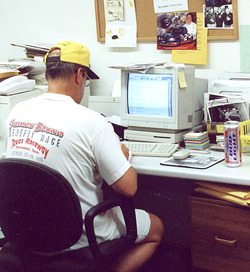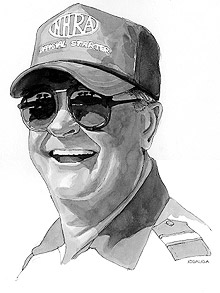 photo by Jeff Burk
photo by Jeff Burk
|
GOODBYE TO BUSTER
From what I've heard, my friend and former NHRA co-worker Buster Couch
slid into his favorite easy chair at his home in Georgia this past January
12 and nodded off ... for good, as it were.
Undoubtedly, there has been much copy generated by the passing of NHRA's
starter of all starters, the most obvious source being his now former
employers. If anybody deserved it and his apparent easy moment of exit,
it was Buster. If you leave aside the famous drag racers and NHRA founder
Wally Parks, Buster probably was drag racing's most recognizable personality.
He was the sport's human Christmas Tree. Any photo of an NHRA national
event from 1963 until he retired for a company operations tower job
in the mid-1990s had Buster in the foreground. Think of the great races:
the Garlits vs. Carbone Indy Burndown of 1971, Shirley vs. Connie Kalitta
in 1982, Force's first Funny Car national event win, you name it, there
was Buster in the middle of the two cars, switch box in hand.
 |
|
Drawing by John Jodauga
|
When you think about it, the job wasn't all that difficult, technically
speaking. You waited until the two racers did their burnouts, pre-staged
and staged, then you hit the switch to activate the Tree. I'm being
a little facetious here as obviously that's true only in the most rigid
definition. Yes, NHRA Grand Marshalls got to work the Tree, but not
for 12 hours a day and not having to deal with the variety of problems
that cropped up when 500 extremely competitive individuals get together
to battle it out for cash and them formerly valuable Winston points
... now I guess, POWERade squirts.
The one thing that got me about Buster was not his switch-hitting abilities,
but his way of handling people. I think if there was any one person
who knew the racers best individually it had to be Buster. It was a
cold day in hell if a racer put anything over on Buster. He was NHRA's
master psychologist and its Foghorn Leghorn as well.
Some examples.
There was this Super Comp racer who came up to Buster before a round
of competition and told Buster that if he would notice the side of (this
racer's) truck it was inscribed boldly in shoe-polish, "Deep, Deep Stage."
This racer relayed to Buster that this meant that he wanted Buster to
hold on to the switch so that he could stage with the very back edge
of his tire. He then would be courteous enough to nod to Buster that
it was okay, that he could throw the switch.
So, the guy comes up to the line and as soon as the front edge of his
front tire just tickles the light, Buster throws the switch. The startled
racer took off too soon and red-lighted, no doubt coasting down his
lane in disgust.
Buster remembered the guy and when he towed up the return road a little
later, the NHRA starter ran up to his truck and said, "I couldn't remember
whether you said, you'd wave, nod, or just left it up to me, so I just
let her go." The guy mumbled it was all right, having grabbed the essential
message of the incident: When you're talking starting line, you're talking
Buster's House.
Top Fuel racer Frank Bradley knew that Buster had a deathly fear of
snakes. At one national event, Bradley pulled into the water box and
did a big smoker and as he did so, threw a large black rubber snake
out at Buster, who promptly jumped up and back, momentarily shocked.
Bradley's next run had different characteristics. He did his burnout,
backed up, and staged. His pre-stage light was on and Buster came over
to his cackling fueler and promptly dumped two hotel buckets of ice
in the cockpit on top of Bradley and then hit the switch.
A Top Fuel Bike racer had done his burnouts and was staged when Buster
noticed he had no eye protection on. He merely reached over to his son
Mike, yanked off his wrap-around shades, slapped them on the racer,
and gave him the green.
And one more (there are dozens upon dozens of Buster starting line
stories). Connie Kalitta, an old pal and cohort of Buster's, did his
burnout and as he was staging gave his old pal the rigid digit with
his right hand. Kalitta moved into stage, and with his right hand, Buster
gouged out a big ole booger and put it on Kalitta's face shield and
sent him on his way.
Buster Couch was a character, one that was generated by his genuine
fondness of people.
When I got my job in 1975 at NHRA and leaving aside the headquarters
staff at Toluca Lake, the first person I met was Buster. He wanted to
meet me after seeing me in the Englishtown pits with hair down to my
shoulder blades: The sport's biggest redneck meeting the sanctioning
body's first long-haired radical, dope-smoking hippie. He had me over
to his table and in a serious fatherly way told me, "Goofus, I don't
mind drinkin' moonshine, cussin' or fightin', but ya'll lay off that
wacky tobacky, it'll make you goofy." This coming from a guy who had
that description thrown his way a time or two.
He took me through the pits at that event, the 1975 Summernationals,
and introduced me to my first pro racer, Roy Hill, and every single
competitor who originated south of the Mason-Dixon. I was honored.
And I was honored to have known such a great guy. He loved kids and
he loved the fans. He was as flattered as you were if you asked for
his autograph. At NHRA, he was among my very favorite people, a guy
who just was a real magnet. He always drew attention and it was good
attention. People were glad to see him.
In my parents' house, I have a framed picture of me and brother Ernie
sitting on the power box just behind the Englishtown starting line after
the races, flanking a smiling, jovial Buster Couch. These days I don't
get to the races that much, and I miss them. Not so much the events
themselves, but for a number of people that have branded their positive
images deep within the recesses of what's left of my memory. People
like Buster Couch.
If indeed it isn't nothingness and eternity facing us all, then I say,
Buster, may there be Jack Daniels in Heaven.
|